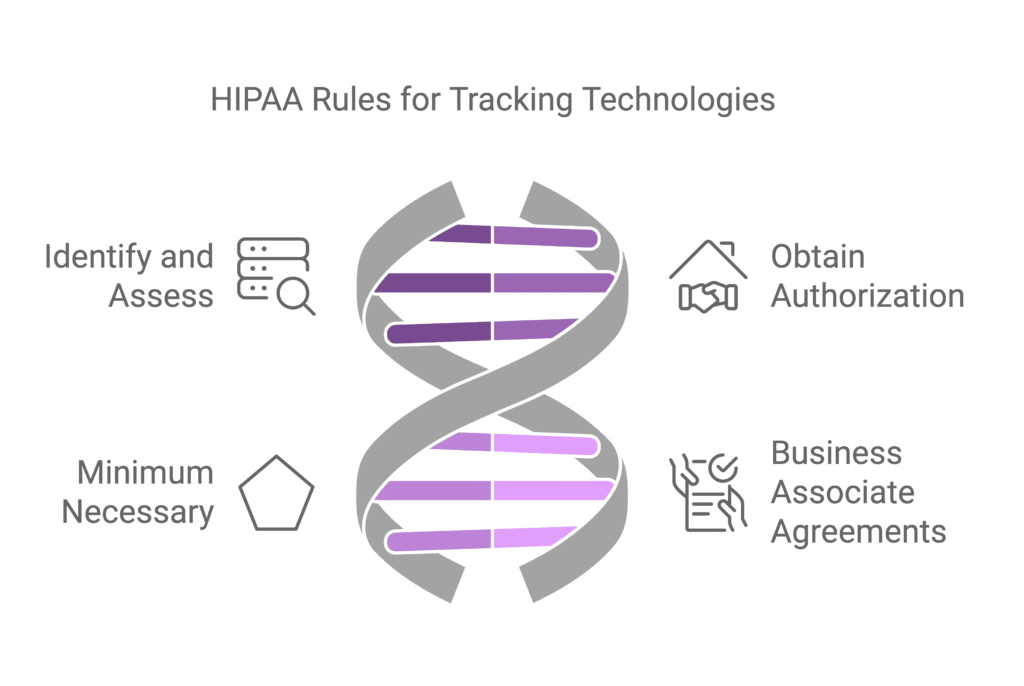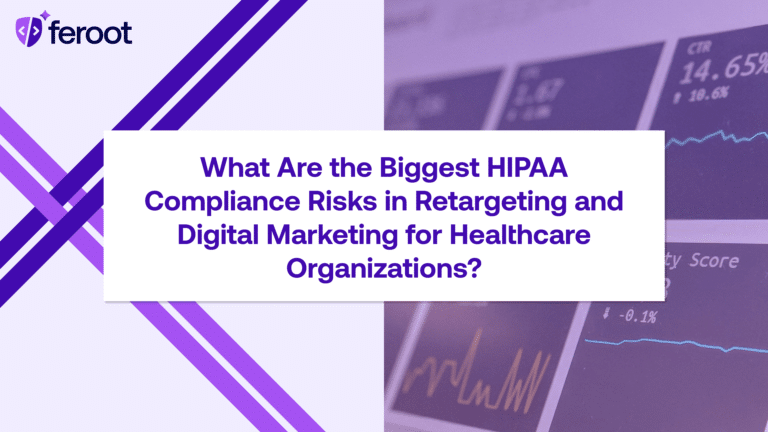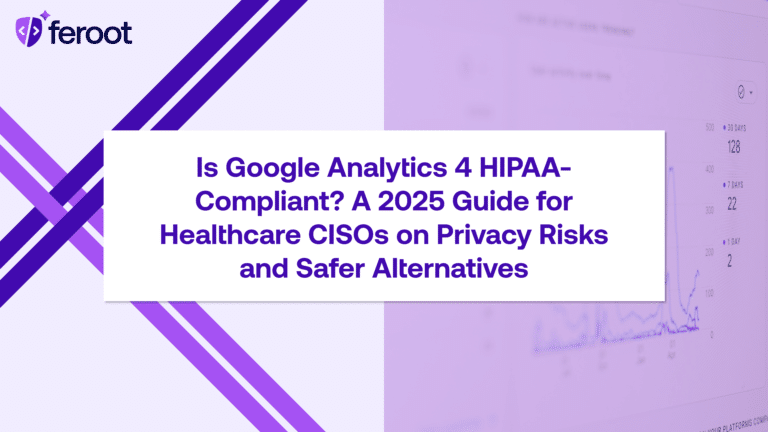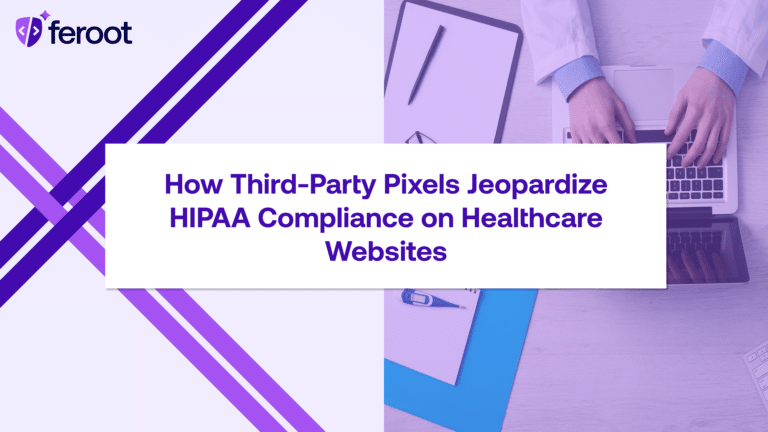TL;DR
- Tracking pixels, scripts, and tags are everywhere — and most operate invisibly. They are used for analytics and ads, these tools often collect personal data without user consent or awareness.
- Client-side risks are blind spots for most security and compliance teams. Shadow code and third-party scripts can introduce data leakage, supply chain risk, and regulatory exposure.
- Compliance frameworks now require visibility into browser-side behavior. PCI DSS 4.0 (Req. 6.4.3, 11.6.1), GDPR, and HIPAA demand control over unauthorized or unvalidated scripts.
- Feroot helps teams detect, monitor, and block risky tracking technologies. Get real-time visibility into what’s happening in the browser, enforce security policies, and stay audit-ready.
Introduction
Today, healthcare providers, insurers, and other HIPAA-covered entities are increasingly relying on websites to share information, engage with patients, and streamline operations. While websites offer numerous benefits, it’s crucial to understand the implications of online tracking technologies for the privacy and security of protected health information (PHI). This blog post examines the intersection of websites, online tracking, and HIPAA compliance, providing essential insights for safeguarding sensitive health data.
What are Online Tracking Technologies, and Why Should You Care?
Online tracking technologies are snippets of code embedded in websites to monitor user behavior, gather data, and tailor browsing experiences. Common examples include cookies, web beacons, and session replay scripts. While these technologies are often used for legitimate purposes like website analytics and personalized content, they can also pose significant privacy risks if they capture and transmit PHI without proper authorization and safeguards. In many cases, these trackers are working in “stealth” mode and the ephemeral nature of most web experiences makes detecting them complex.

HIPAA and Websites: Where the Rubber Meets the Road
The Health Insurance Portability and Accountability Act of 1996 (HIPAA) establishes stringent regulations for protecting the privacy, security, and integrity of PHI. These regulations extend to websites operated by HIPAA-covered entities and their business associates, governing the collection, use, and disclosure of PHI online. Failure to comply with HIPAA regulations can result in hefty fines (in the millions of dollars), legal ramifications, and reputational damage.
Key Considerations for HIPAA Compliance on Websites:

- Identify and Assess: Conduct a thorough inventory of all tracking technologies implemented on your website, including those from third-party vendors. Evaluate the types of data collected by each technology and determine whether any PHI is being captured, transmitted, or stored.
- Obtain Authorization: Unless an exception applies, HIPAA requires obtaining valid authorization from individuals before disclosing their PHI to tracking technology vendors, commonly referred to as a Business Associate Agreement. It’s important to note that simply mentioning the use of tracking technologies in a website’s privacy policy does not constitute valid HIPAA authorization.
- Minimum Necessary: Adhering to the HIPAA minimum necessary standard is critical. Limit the collection, use, and disclosure of PHI to the minimum amount required for the specific purpose. Avoid collecting or transmitting PHI that is not essential for the functionality of your website or the services provided.
- Business Associate Agreements (BAA): If a tracking technology vendor meets the definition of a business associate under HIPAA, a legally binding BAA must be in place. The BAA outlines each party’s responsibilities regarding PHI and establishes safeguards for protecting the privacy and security of the data.
- Implement Technical and Administrative Safeguards: Employ robust technical and administrative safeguards to protect ePHI collected through your website. Encryption, access controls, audit trails, and regular risk assessments are critical components of a comprehensive HIPAA security program.
What Are the Financial and Legal Consequences of Non-Compliant Tracking Technologies?
Between 2023 and 2025, U.S. healthcare organizations faced over $100 million in fines due to unauthorized use of tracking technologies like Meta Pixel and Google Analytics. These penalties often stemmed from:
- Collecting PHI without valid patient authorization
- Failing to establish Business Associate Agreements (BAAs) with third-party vendors
- Neglecting to conduct comprehensive risk assessments
For instance, Advocate Aurora Health incurred a $12.25 million fine for deploying tracking pixels on patient portals without proper safeguards. Such incidents underscore the critical need for stringent compliance measures.
How Can Healthcare Organizations Ensure Compliance with Tracking Technologies?
To navigate the complexities of HIPAA compliance concerning online tracking, healthcare entities should consider the following steps:
- Conduct a Comprehensive Audit: Identify all tracking technologies in use across your digital platforms.
- Assess Data Collection Practices: Determine whether these technologies collect PHI and evaluate the necessity of such data collection.
- Establish BAAs with Vendors: Ensure that all third-party vendors handling PHI have signed BAAs outlining their responsibilities.
- Implement Technical Safeguards: Utilize encryption, access controls, and monitoring tools to protect collected data.
- Regularly Review and Update Policies: Stay informed about changes in regulations and adjust your practices accordingly.
By proactively addressing these areas, healthcare organizations can mitigate risks associated with online tracking technologies and maintain compliance with HIPAA regulations.
Staying Ahead of the Curve
Navigating the complexities of HIPAA compliance in the digital age requires ongoing diligence and a proactive approach. Regularly review and update your website’s privacy and security practices, remain informed about evolving regulations and guidance from the Department of Health and Human Services (HHS), and prioritize the protection of your users’ sensitive health information. By making HIPAA compliance a top priority, you can leverage the power of websites while upholding the privacy and trust of those you serve.
FAQs
What are tracking technologies, and why are they a security risk?
Tracking technologies include scripts, pixels, cookies, and tags that monitor user behavior. When unmanaged, they can leak sensitive data, violate privacy laws, and serve as attack vectors for malicious actors.
How do tracking technologies impact compliance with frameworks like GDPR or PCI DSS?
Many regulations now require organizations to monitor and control client-side activity. For example, PCI DSS 4.0 explicitly mandates protection against unauthorized scripts on payment pages, and GDPR requires transparency around user data collection.
Can marketing tools like Meta Pixel or Google Tag Manager violate compliance rules?
Yes — if these tools collect personal data without user consent or if they operate in regions with strict data sovereignty laws (e.g., GDPR), they can trigger violations. Shadow code and unapproved script behavior are especially risky.
How can security teams monitor what scripts are running in browsers?
Traditional security tools don’t track what happens in the browser. Client-side security platforms like Feroot fill this gap by continuously monitoring scripts, blocking unauthorized code, and mapping controls to compliance frameworks.
Does Feroot block or just monitor tracking technologies?
Feroot provides both monitoring and enforcement. It identifies unauthorized scripts in real time and allows teams to block or control them based on security policy and compliance requirements.


